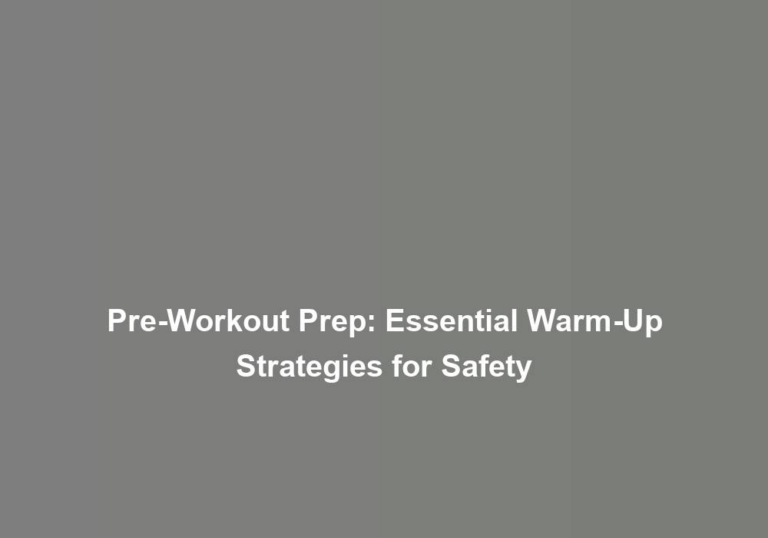The Art of the Warm-Up: Key Techniques to Prevent Injuries
You know that feeling when youG??re about to dive into a workout, and you just want to jump right in? ItG??s tempting to skip the warm-up and get straight to the main event, but taking the time to properly prepare your body can make all the difference. In this discussion, weG??ll explore the essential techniques for warming up effectively, from dynamic stretching to muscle activation exercises. By the end, youG??ll have a solid understanding of how to prevent injuries and maximize your performance during any physical activity.
Importance of Warm-Up
Engaging in a proper warm-up routine before physical activity is essential in reducing the risk of injuries and preparing your body for the demands of exercise. The benefits of a thorough warm-up are numerous. First and foremost, it increases the temperature of your muscles, making them more pliable and reducing the risk of strains and tears. Additionally, a good warm-up increases blood flow to the muscles, which enhances flexibility and range of motion, further reducing the risk of injury during exercise. Moreover, it prepares your cardiovascular system for the upcoming physical exertion, gradually increasing your heart rate and allowing your body to transition into a higher intensity workout more smoothly.
Injury prevention is a key focus of any warm-up routine. By gradually increasing the intensity of your physical activity, a warm-up allows your body to adjust to the upcoming demands, which can help prevent overuse injuries. It also provides an opportunity to identify any areas of tightness or discomfort, allowing you to address these issues before they become more serious problems during your workout.
Dynamic Stretching Techniques
To build on the importance of a thorough warm-up routine in injury prevention, letG??s now focus on dynamic stretching techniques that can effectively prepare your muscles for physical activity. Dynamic stretching involves moving your muscles and joints through a full range of motion, which helps improve flexibility and enhances overall performance. This type of stretching is particularly beneficial for injury prevention as it increases blood flow, warms up the muscles, and prepares them for the demands of exercise.
Dynamic warm-ups have been shown to have significant flexibility benefits. By actively engaging the muscles and gradually increasing their range of motion, dynamic stretching helps improve flexibility, which is essential for preventing injuries during physical activity. It also helps to enhance muscle coordination and balance, further reducing the risk of strains and sprains.
Moreover, dynamic stretching plays a crucial role in injury prevention. By incorporating dynamic movements that mimic the activities you are about to perform, you are effectively preparing your muscles, tendons, and ligaments for the specific demands of your workout or sport. This targeted preparation reduces the likelihood of overstretching or straining the muscles during exercise, thereby lowering the risk of injury.
Incorporating dynamic stretching techniques into your warm-up routine is a practical and evidence-based approach to injury prevention. By prioritizing dynamic warm-ups, you can optimize your flexibility, enhance your performance, and significantly reduce the risk of exercise-related injuries.
Activation Exercises for Muscles
You can optimize your warm-up routine by incorporating specific activation exercises that target key muscle groups, preparing them for the upcoming physical activity. Muscle activation exercises are essential for priming your muscles, enhancing their ability to generate force, and reducing the risk of injury during your workout. When performed correctly, these exercises improve neuromuscular control and coordination, ultimately leading to better movement patterns and overall performance.
To activate your muscles effectively, focus on exercises that mimic the movements youG??ll be doing during your main workout. For example, if youG??re planning to do squats, incorporating bodyweight squats or resistance band walks into your warm-up can help activate the glutes, quadriceps, and hamstrings. Similarly, if youG??re preparing for upper body exercises, performing arm circles or resistance band pull-aparts can activate the muscles in your shoulders, chest, and upper back.
Incorporating dynamic movements, such as leg swings, arm swings, and hip circles, can also help enhance muscle activation while promoting flexibility and mobility. These exercises stimulate blood flow to the muscles, increase joint range of motion, and prepare your body for more intense physical activity.
Incorporating Mobility Drills
Incorporating mobility drills into your warm-up routine can further enhance muscle activation and promote joint flexibility and mobility, building upon the foundations laid by activation exercises. Joint mobility exercises are designed to improve the range of motion in specific joints, allowing for better movement and reducing the risk of injury during physical activity. These drills involve dynamic movements that target the major joints in the body, such as the shoulders, hips, knees, and ankles. By incorporating mobility drills into your warm-up, you can specifically address any areas of stiffness or tightness, ensuring that your body is primed for the demands of your workout.
Flexibility exercises are another essential component of a well-rounded warm-up routine. These exercises focus on lengthening and stretching the muscles, tendons, and ligaments to improve overall flexibility and range of motion. Including dynamic stretches in your warm-up can help prepare your body for the movements it will perform during exercise, reducing the risk of strains and sprains.
Incorporating mobility drills and flexibility exercises into your warm-up routine can have numerous benefits, including improved performance and reduced risk of injury. By taking the time to address joint mobility and flexibility before your workout, you are actively investing in the long-term health and functionality of your body. These simple yet effective techniques can make a significant difference in your overall physical well-being, allowing you to move more freely and confidently during your workouts.
Gradual Progression and Intensity
Gradually increasing the intensity of your warm-up activities allows your body to acclimate to the upcoming workout, preparing your muscles, joints, and cardiovascular system for the demands of physical exertion. Progressive warm-up routines are essential for priming your body and preventing potential injuries. Start with low-intensity movements, such as walking or gentle stretching, and then gradually increase the intensity. This can involve incorporating dynamic movements like leg swings, arm circles, and bodyweight exercises to elevate your heart rate and stimulate blood flow to your muscles.
Intensity control is crucial during this phase. Pay attention to your bodyG??s response and adjust the intensity accordingly. As you progress through your warm-up, your heart rate should gradually rise, and you should start to break a light sweat. However, itG??s important to avoid pushing yourself too hard too soon, as this can lead to fatigue or even injury. Aim to reach a moderate level of intensity by the end of your warm-up, where you feel warm, energized, and ready to tackle your main workout.
Conclusion
In conclusion, the art of the warm-up is essential for preventing injuries and optimizing performance. By incorporating dynamic stretching, activation exercises, mobility drills, and gradually increasing intensity, you can prepare your body for physical activity. Research has shown that a proper warm-up can improve muscle function and reduce the risk of injury. So next time you hit the gym or the field, make sure to dedicate time to warming up to ensure a safe and effective workout.







